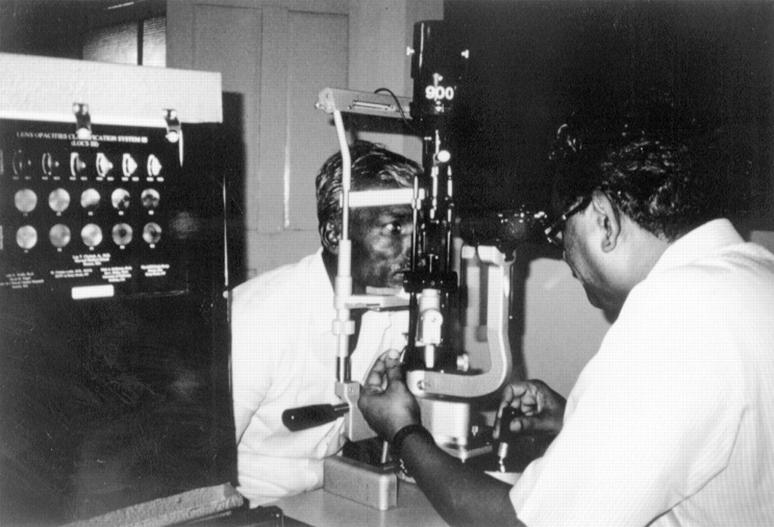Abstract
AIMS—The study was undertaken to test the feasibility of using the LOCS III cataract grading scale in the field and to determine the rate of cataract progression over a 1 year period of time. METHODS—For 150 subjects between the ages of 33 and 55 who attended the refraction clinic at Aravind Eye Hospital in Madurai, India, lens abnormalities were graded at the slit lamp using the LOCS III scale. One year later, 99 of the subjects were re-evaluated by the same methodology to assess the amount of lens change. RESULTS—Interrater reliability was high. A change of 0.5 or more in lens colour, cortical, nuclear, or posterior subcapsular cataract was observed in at least one eye of 54% of the subjects. CONCLUSION—The LOCS III grading scale is a feasible method for measuring lens changes in the field with the slit lamp. Cataract progression in India is rapid enough to permit intervention studies to be performed with relatively small numbers of subjects over a short period of time (that is, 600 subjects for 2 years).
Full Text
The Full Text of this article is available as a PDF (96.3 KB).
Figure 1 .
The arrangement at Aravind Hospital, Madurai, India, for examining and grading the subjects at the slit lamp.
Selected References
These references are in PubMed. This may not be the complete list of references from this article.
- Bunce G. E., Kinoshita J., Horwitz J. Nutritional factors in cataract. Annu Rev Nutr. 1990;10:233–254. doi: 10.1146/annurev.nu.10.070190.001313. [DOI] [PubMed] [Google Scholar]
- Byers T., Marshall J., Fiedler R., Zielezny M., Graham S. Assessing nutrient intake with an abbreviated dietary interview. Am J Epidemiol. 1985 Jul;122(1):41–50. doi: 10.1093/oxfordjournals.aje.a114085. [DOI] [PubMed] [Google Scholar]
- Chatterjee A., Milton R. C., Thyle S. Prevalence and aetiology of cataract in Punjab. Br J Ophthalmol. 1982 Jan;66(1):35–42. doi: 10.1136/bjo.66.1.35. [DOI] [PMC free article] [PubMed] [Google Scholar]
- Chylack L. T., Jr, Leske M. C., McCarthy D., Khu P., Kashiwagi T., Sperduto R. Lens opacities classification system II (LOCS II) Arch Ophthalmol. 1989 Jul;107(7):991–997. doi: 10.1001/archopht.1989.01070020053028. [DOI] [PubMed] [Google Scholar]
- Chylack L. T., Jr, Wolfe J. K., Singer D. M., Leske M. C., Bullimore M. A., Bailey I. L., Friend J., McCarthy D., Wu S. Y. The Lens Opacities Classification System III. The Longitudinal Study of Cataract Study Group. Arch Ophthalmol. 1993 Jun;111(6):831–836. doi: 10.1001/archopht.1993.01090060119035. [DOI] [PubMed] [Google Scholar]
- Collman G. W., Shore D. L., Shy C. M., Checkoway H., Luria A. S. Sunlight and other risk factors for cataracts: an epidemiologic study. Am J Public Health. 1988 Nov;78(11):1459–1462. doi: 10.2105/ajph.78.11.1459. [DOI] [PMC free article] [PubMed] [Google Scholar]
- Cummings S. R., Block G., McHenry K., Baron R. B. Evaluation of two food frequency methods of measuring dietary calcium intake. Am J Epidemiol. 1987 Nov;126(5):796–802. doi: 10.1093/oxfordjournals.aje.a114716. [DOI] [PubMed] [Google Scholar]
- Karbassi M., Khu P. M., Singer D. M., Chylack L. T., Jr Evaluation of lens opacities classification system III applied at the slitlamp. Optom Vis Sci. 1993 Nov;70(11):923–928. doi: 10.1097/00006324-199311000-00009. [DOI] [PubMed] [Google Scholar]
- Kupfer C. Bowman lecture. The conquest of cataract: a global challenge. Trans Ophthalmol Soc U K. 1985;104(Pt 1):1–10. [PubMed] [Google Scholar]
- Magno B. V., Datiles M. B., 3rd, Lasa S. M. Senile cataract progression studies using the Lens Opacities Classification System II. Invest Ophthalmol Vis Sci. 1993 May;34(6):2138–2141. [PubMed] [Google Scholar]
- Maraini G., Pasquini P., Tomba M. C., Bonacini M., Stazi M. A., Rosmini F., Sperduto R. D. An independent evaluation of the Lens Opacities Classification System II (LOCS II). The Italian-American Cataract Study Group. Ophthalmology. 1989 May;96(5):611–615. doi: 10.1016/s0161-6420(89)32841-7. [DOI] [PubMed] [Google Scholar]
- Minassian D. C., Mehra V. 3.8 million blinded by cataract each year: projections from the first epidemiological study of incidence of cataract blindness in India. Br J Ophthalmol. 1990 Jun;74(6):341–343. doi: 10.1136/bjo.74.6.341. [DOI] [PMC free article] [PubMed] [Google Scholar]
- Minassian D. C., Mehra V., Verrey J. D. Dehydrational crises: a major risk factor in blinding cataract. Br J Ophthalmol. 1989 Feb;73(2):100–105. doi: 10.1136/bjo.73.2.100. [DOI] [PMC free article] [PubMed] [Google Scholar]
- Sparrow J. M. Methods of clinical cataract grading: two systems compared. Arch Ophthalmol. 1990 Sep;108(9):1209–1210. doi: 10.1001/archopht.1990.01070110025006. [DOI] [PubMed] [Google Scholar]
- Taylor H. R., Lee J. A., Wang F., Muñoz B. A comparison of two photographic systems for grading cataract. Invest Ophthalmol Vis Sci. 1991 Mar;32(3):529–532. [PubMed] [Google Scholar]
- Varma S. D., Beachy N. A., Richards R. D. Photoperoxidation of lens lipids: prevention by vitamin E. Photochem Photobiol. 1982 Dec;36(6):623–626. doi: 10.1111/j.1751-1097.1982.tb09481.x. [DOI] [PubMed] [Google Scholar]
- Varma S. D., Kumar S., Richards R. D. Light-induced damage to ocular lens cation pump: prevention by vitamin C. Proc Natl Acad Sci U S A. 1979 Jul;76(7):3504–3506. doi: 10.1073/pnas.76.7.3504. [DOI] [PMC free article] [PubMed] [Google Scholar]
- Varma S. D., Srivastava V. K., Richards R. D. Photoperoxidation in lens and cataract formation: preventive role of superoxide dismutase, catalase and vitamin C. Ophthalmic Res. 1982;14(3):167–175. doi: 10.1159/000265189. [DOI] [PubMed] [Google Scholar]



